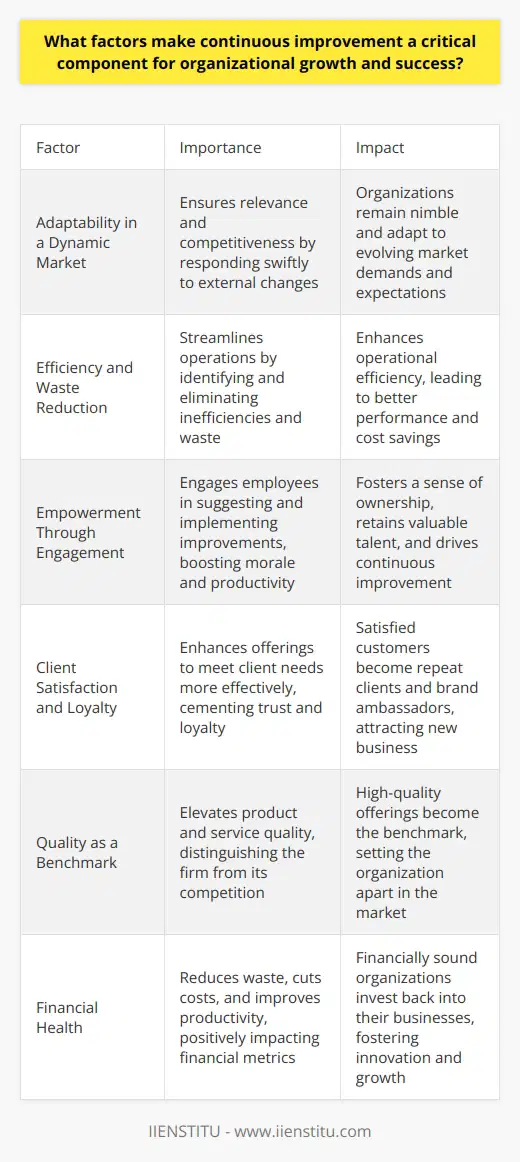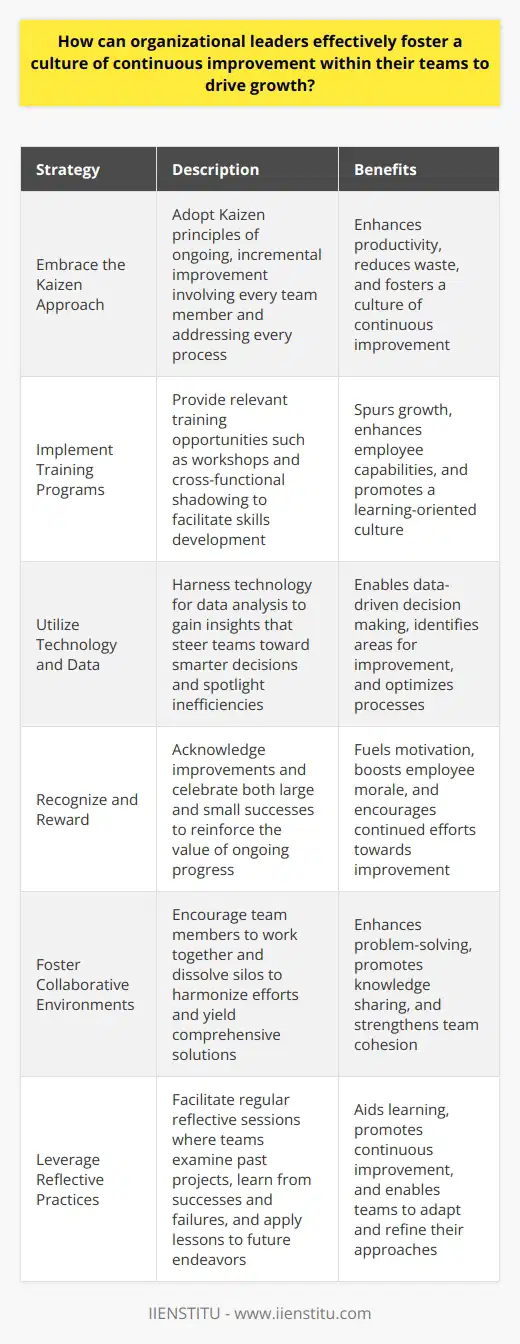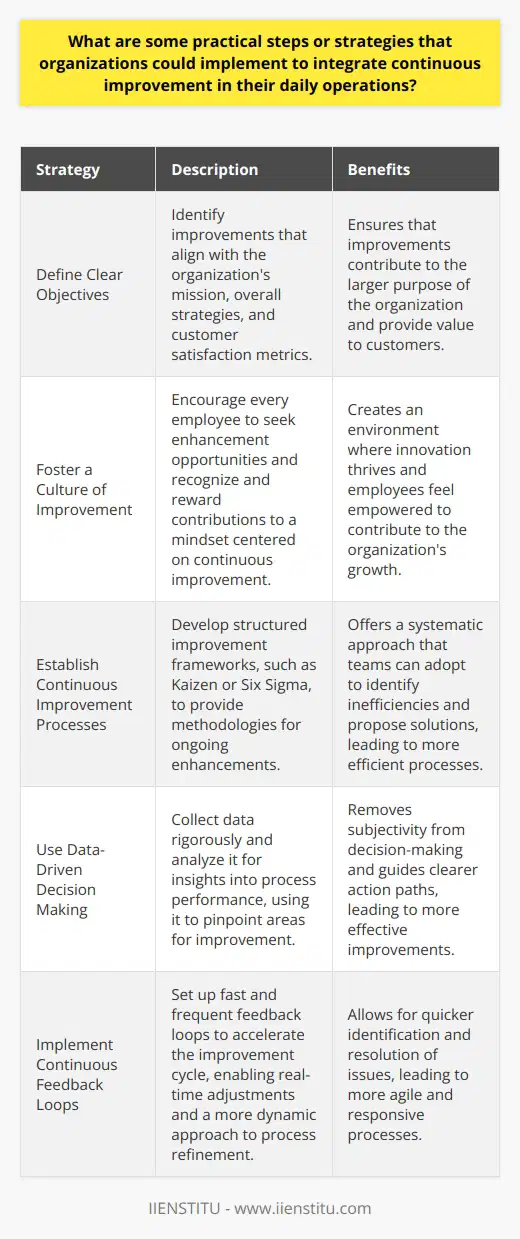
I still remember my first encounter with the concept of continuous improvement. It was during a summer internship at a manufacturing company where I witnessed firsthand how small, incremental changes could lead to significant enhancements in efficiency and quality. That experience ignited a passion for exploring the transformative potential of this approach and understanding how it can be harnessed for organizational growth and success.
What is Continuous Improvement?
At its core, continuous improvement is a philosophy that emphasizes the ongoing effort to elevate processes, products, and services. It is not a one-time event but rather a never-ending journey of making what is good even better. This mindset is applicable across various sectors, from manufacturing and healthcare to education and technology.
The origins of continuous improvement can be traced back to post-World War II Japan, where industries were in dire need of efficient practices to rebuild the nation's economy. Pioneers like W. Edwards Deming introduced quality control methods that stressed the importance of constant incremental changes. These principles, deeply ingrained in Japanese culture, later evolved into influential global business practices.
Statistical Process Control Techniques For Quality Management
Manager's Role İn Organizations Key Insights Pdf Effective Leadership Strategies
Principles of Continuous Improvement
Focus on process, not people: Continuous improvement recognizes that the systems and processes in which individuals operate significantly influence their performance and output quality. Rather than attributing inefficiencies to people, it seeks to transform processes to enable workers to achieve better results.
Work smarter, not harder: By analyzing and revising workflows, removing unnecessary steps, and employing automation where applicable, continuous improvement promotes a "work smarter, not harder" ethos. This approach enhances productivity without increasing workload.
Team-oriented approach: Empowering teams to actively participate in problem-solving and process optimization leads to shared ownership of both the processes and the outcomes. Collaboration and collective insights are at the forefront of innovation in a continuous improvement environment.
Businesses that internalize these principles virtually program themselves for perpetual growth. They consistently seek out areas for development, leverage data-driven insights for decision-making, and adapt to market changes while improving customer experiences and fostering an engaged workforce.
Approaches to Continuous Improvement
There are several well-established approaches to implementing continuous improvement, each with its unique attributes and benefits:
Kaizen - The Japanese strategy: Kaizen, meaning "change for better," encompasses the philosophy of continuous and incremental improvement. It stimulates a culture where employees at all levels are actively engaged in suggesting and implementing improvements to the company's processes. Small, iterative changes collectively lead to significant benefits such as reduced waste, improved efficiency, and enhanced team morale.
Six Sigma - A statistical-based approach: Six Sigma is a structured, data-driven approach aimed at process improvement and variation reduction through the application of statistical tools. By adhering to a set methodology, organizations can achieve near-perfect quality and substantial cost savings. The rigorous application of Six Sigma principles enables the identification and elimination of defects, leading to higher customer satisfaction, improved product consistency, enhanced process control, and increased profitability.
Lean manufacturing - Elimination of waste: Lean manufacturing revolves around the elimination of waste within any given system without sacrificing productivity. It focuses on adding value for the customer while minimizing resources, time, energy, and effort. Organizations employing lean principles experience lower operational costs, shorter cycle times, and a sharp focus on customer value, translating into a competitive advantage and a robust foundation for innovation and quality improvement.
Implementing Continuous Improvement: A Step-by-Step Guide
Embarking on a continuous improvement journey requires a systematic approach. Here are the key steps to successfully implement this transformative strategy:
Identify areas for improvement: Start by thoroughly understanding current operations and pinpointing areas prone to inefficiencies. Meticulous observation and data collection are essential to spot problem areas that can be refined.
Establish performance standards: Set clear and measurable performance standards to gauge the effectiveness of current processes. These benchmarks will facilitate objective evaluations of change initiatives.
Develop and implement an action plan: Craft a detailed action plan that outlines steps for change, designates responsibilities, and stipulates timelines. Transparent communication and the preparedness of all involved parties to adapt to new procedures are crucial for successful implementation.
Evaluate progress and gather feedback: Regularly assess progress against predefined standards to gauge the success of continuous improvement efforts. Feedback loops ensure that strategies are fine-tuned and adapted in response to challenges and opportunities.
Repeat the process for ongoing enhancement: Continuous improvement is an iterative process. Organizations should repeat the cycle, using insights gained from each iteration to inform further refinements. This approach solidifies improvements and embeds a culture of excellence.
Real-world Success Stories
Numerous organizations worldwide have harnessed the power of continuous improvement to realize remarkable gains. Toyota, for example, has been a trailblazer in demonstrating how consistent incremental changes can lead to industry-leading quality and efficiency. Their renowned Toyota Production System has become a model for manufacturers globally.
Another notable example is Amazon, which has relentlessly focused on optimizing its processes to deliver unparalleled customer satisfaction. From their innovative inventory management to their streamlined delivery systems, Amazon's commitment to continuous improvement has been a driving force behind their meteoric rise.
Cause And Effect Analysis For Decision Making Transformation
Comprehensive Definition Of Logistics And İts Role İn Business
These success stories underscore the transformative potential of continuous improvement. The outcomes typically include enhanced product quality, greater market share, and a loyal customer base. The deep engagement of employees in the improvement processes results in sustainable practices that become integral to the company's DNA.
Overcoming Challenges and Embracing a Culture of Improvement
While the benefits of continuous improvement are compelling, the journey is not without its challenges. Resistance to change, lack of alignment within the organization, and inadequate communication can impede progress. To navigate these hurdles, leaders must foster an inclusive culture that values employee contributions and provides the necessary training and support.
Investing in employee development through initiatives like problem-solving courses and online certificate programs can equip teams with the skills needed to drive continuous enhancement. Recognizing and celebrating successful outcomes further reinforces the importance of this approach and encourages ongoing participation.
The Path Forward: Embracing Continuous Improvement for Long-term Success
Continuous improvement is not a destination but a journey of relentless pursuit. It demands a commitment from every level of an organization to consistently refine and reevaluate operational processes. While the path may be challenging, the rewards are immeasurable.
Businesses that wholeheartedly adopt continuous improvement strategies position themselves for long-term viability and prosperity. They create an agile infrastructure capable of swiftly responding to industry developments and evolving customer demands. By embracing this transformative approach, organizations unlock the potential for exponential growth, innovation, and enduring success.
So, let us embark on this journey together, armed with the tools, mindset, and determination to make a lasting impact. The power of continuous improvement awaits, ready to transform our organizations from within and propel us towards a future of boundless possibilities.
Remember, every step towards improvement, no matter how small, contributes to the larger vision of organizational excellence. Let us embrace this journey with open minds, collaborative spirits, and an unwavering commitment to making a difference.
Frequently Asked Questions
What factors make continuous improvement a critical component for organizational growth and success?
Continuous Improvement: A Pillar of Organizational Success
Continuous improvement stands as a keystone in modern business strategies. It embodies an ongoing commitment to refining services, products, and processes. Through this relentless pursuit, organizations better adapt to the ever-changing market demands and expectations.
Adaptability in a Dynamic Market
Organizations must remain nimble. Markets evolve at a breakneck pace. Customer preferences shift with trends and technology. Competitors innovate, raising industry standards. In this landscape, continuous improvement ensures relevance and competitiveness. It allows firms to respond swiftly to external changes.
Change as a Constant
Business environments embrace change as inevitable. Those who adapt, flourish. Those who stagnate, fail. Continuous improvement fosters a culture accepting of change. It equips teams to face transformation as a regular aspect of business life.
Efficiency and Waste Reduction
A core feature of continuous improvement involves streamlining operations. This process uncovers inefficiencies within systems. It highlights waste, whether in time, resources, or effort. By identifying and eliminating these excesses, organizations enhance their operational efficiency. This, in turn, feeds into better performance and cost savings.
Empowerment Through Engagement
Employees drive continuous improvement. Their engagement proves critical. When staff suggest and implement improvements, they feel empowered. This sense of ownership boosts morale. High morale often translates to heightened productivity. Moreover, it retains valuable talent within the organization.
Client Satisfaction and Loyalty
A direct link exists between improvement and customer satisfaction. As companies enhance their offerings, they meet client needs more effectively. This responsiveness cements trust and loyalty. Satisfied customers often become repeat clients. They may also serve as brand ambassadors, attracting new business.
Quality as a Benchmark
Quality sets businesses apart. Continuous improvement aims to elevate product and service quality. With each iteration, organizations can enhance their outputs. High-quality offerings become the benchmark, distinguishing a firm from its competition.
Financial Health
Financial metrics matter greatly. Continuous improvement can impact these positively. Reducing waste cuts costs. Streamlining processes improves productivity. Both effects can bolster profit margins. Financially sound organizations invest back into their businesses. They innovate and grow.
The Long-Term View
Sustained success requires a long-term perspective. Continuous improvement aligns with this view. It initiates progress on an incremental basis. Small, consistent enhancements accumulate over time. They lead to significant advancements. This progression underpins enduring growth and stability.
- Adapt or Perish
- Empower to Engage
- Satisfy to Succeed
- Quality Above All
- Finances in Focus
- Endure and Prosper
Each factor highlights the centrality of continuous improvement in business. It is not an option but a necessity. It characterizes organizations poised for growth and success. It ensures they not only survive but also thrive in the cutthroat world of business.

How can organizational leaders effectively foster a culture of continuous improvement within their teams to drive growth?
Understanding Continuous Improvement
Continuous improvement stands as a cornerstone in organizational growth. It reflects a ceaseless pursuit of betterment. This practice centers on incremental enhancements. It transcends simple task execution. It becomes integral to organizational fabric.
Leadership's Role in Cultivating Improvement
Organizational leaders bear a unique responsibility. They must craft and nurture the right conditions. These conditions must encourage perpetual growth. Leaders function as catalysts for change. They exemplify improvement behaviors. They set clear expectations. They channel resources effectively. They provide support where necessary.
Setting a Vision
Vision guides continuous improvement. Leaders must articulate this vision compellingly. Every team member should grasp the larger context. They should perceive how their contributions shape outcomes.
Establishing Trust
Trust forms the bedrock of improvement efforts. Leaders must exhibit trust in their teams. In return, teams must trust the process. This mutual trust permits open dialogue. It allows free exchange of ideas.
Encouraging Autonomy
Empowerment boosts continuous improvement. Leaders should entrust team members with autonomy. Autonomy fosters ownership of processes. It stimulates innovative thinking. Leaders must recognize and reward such initiative.
Providing Feedback
Feedback informs continuous improvement. Leaders should deliver consistent, constructive feedback. This feedback must highlight both strengths and areas for development. It also needs to guide team members toward efficiency and innovation.
Practical Strategies for Fostering Continuous Improvement
How do leaders embed a sense of continuous improvement?
Embrace the Kaizen Approach
Kaizen embodies ongoing, incremental improvement. Leaders can adopt Kaizen principles. They involve every team member. They address every process. They focus on enhancing productivity and reducing waste.
Implement Training Programs
Skills development facilitates improvement. Leaders should provide relevant training opportunities. These can range from workshops to cross-functional shadowing. Every learning opportunity can spur growth.
Utilize Technology and Data
Data can illuminate paths to improvement. Leaders should harness technology for data analysis. Insights gained from data steer teams toward smarter decisions. They spotlight inefficiencies for corrective action.
Recognize and Reward
Recognition fuels motivation. Leaders must acknowledge improvements. They must celebrate both large and small successes. This recognition reinforces the value of ongoing progress.
Foster Collaborative Environments
Collaboration harmonizes efforts. Leaders should encourage team members to work together. They should dissolve silos. Team collaboration can yield more comprehensive solutions.
Leverage Reflective Practices
Reflection aids learning. Leaders should facilitate regular reflective sessions. Teams can examine past projects. They learn from successes and failures. They apply those lessons to future endeavors.
Conclusion
Leaders shape the culture of continuous improvement. They require vision, trust, autonomy, and effective feedback mechanisms. They must embrace practical strategies. These include adopting Kaizen, providing training, utilizing data, recognizing efforts, fostering collaboration, and encouraging reflection. Through these means, leaders can drive their teams and entire organizations toward sustainable growth.

What are some practical steps or strategies that organizations could implement to integrate continuous improvement in their daily operations?
Continuous Improvement in Daily Operations
Continuous improvement stands as a pivotal element in an organization’s evolution. It embodies the ongoing effort to enhance products, services, or processes. These improvements can be incremental over time or achieved through significant breakthroughs. However, for organizations to effectively integrate continuous improvement, it requires a clear strategy and firm commitment at all levels.
Define Clear Objectives
Begin with clear goals. Identify what improvements serve the organization's mission. Objectives must align with overall strategies and customer satisfaction metrics. This alignment ensures that improvements contribute to the larger purpose of the organization.
Foster a Culture of Improvement
Build an inclusive culture. Encourage every employee to seek enhancement opportunities. Recognize and reward contributions to a mindset centered on continuous improvement. This acknowledgment can foster an environment where innovation thrives.
Establish Continuous Improvement Processes
Develop structured improvement frameworks. Tools like Kaizen or Six Sigma provide methodologies for ongoing enhancements. They offer a systematic approach that teams can adopt to identify inefficiencies and propose solutions.
Use Data-Driven Decision Making
Make decisions based on data, not instinct. Collect data rigorously. Analyze it for insights into process performance. Rely on this data to pinpoint areas for improvement. Data removes subjectivity and guides clearer action paths.
Encourage Open Communication
Promote transparency and open lines of communication. Allow for the free flow of ideas and feedback across all operational levels. Open communication can surface improvement opportunities that may otherwise remain hidden.
Train and Equip Your Teams
Invest in training. Equip teams with the skills necessary to implement continuous improvement initiatives. Training enhances an individual's ability to not only recognize potential improvements but also to act on them effectively.
Implement Continuous Feedback Loops
Set up fast and frequent feedback loops. Rapid feedback can accelerate the improvement cycle, enabling real-time adjustments and a more dynamic approach to process refinement.
Review and Reflect
Regularly review processes. Reflect on what strategies have or have not worked. Take the time to analyze both successes and failures as learning opportunities that feed back into the continuous improvement cycle.
Incrementally Scale Improvements
Start small, then scale improvements incrementally. Large changes can be overwhelming and disruptive. Smaller changes allow for easier implementation and refinement, paving the way for broader application over time.
Track and Measure Improvement Efforts
Clearly define metrics for measuring improvements. Tracking progress against these metrics provides the evidence needed to understand the impact of changes made and to justify the continuation of improvement efforts.
By embracing these strategies, organizations can weave continuous improvement into the fabric of their daily operations. This integration can lead to sustained efficiency, competitive advantage, and the agility needed to adapt to changing market demands.


